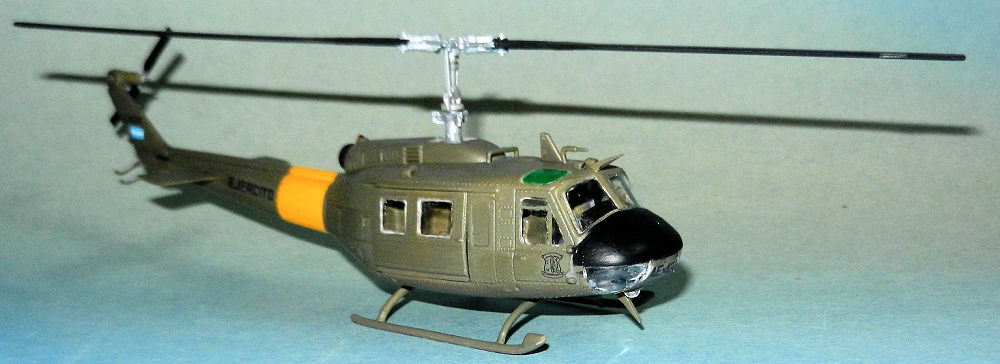
| KIT #: | 0141 |
| PRICE: | CAD$17.00 |
| DECALS: | One option |
| REVIEWER: | Pablo Calcaterra |
| NOTES: | Aerocalcas 72008 decals |

| HISTORY |
Starting 1970, this famous helicopter was incorporated to the Argentine Army. With numbers AE-400 to AE-424, the last one was received in October 1978. Cruise speed is 204 km/h, can carry 10 soldiers and 2 machine guns in the doors, or 24 rockets in 2 rockets launchers. In the Aviation branch of the Army, there were part of the Assault Helicopters “A”, Batallón de Aviación de Combate 601.
In 1975 Miguel San Martín joined the Escuela General Lemos in Campo de Mayo that trains future professionals for the Argentine Army. In 1979 he finished his studies and became 1st Corporal (Aviation Mechanic) specialized in helicopters joining 601.
On April 23, 1982 with several of the other choppers of the
Batallón already in the Malvinas/Falklands Islands, four more Hueys were
disassembled and were prepared to be taken by plane (Hercules belonging to the
Air Force). These were AE-406, 417, 418 and 424. Crew of AE-424 was Capt. Jorge
“Picho” 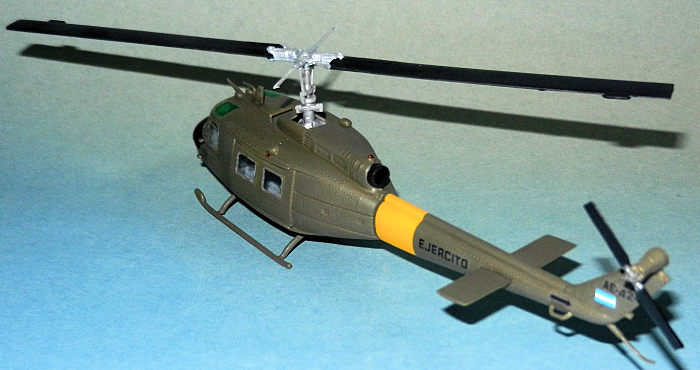 Svendsen, 1st Sgt Miguel Santana (mechanic and copilot) and 1st
Corporal Martín “Negro” San Miguel (mechanic and gunner). After a two-hour
flight, they landed in the runway and immediately proceeded to push the 424 out
of the Hercules TC-65. Army ground crew and the crews from the helos proceeded
to work to put them together again (attaching the main blades and the ones on
the tail). In less than 48 hs the helo was ready to fly again. Svendsen was in
charge of B Assault Flight (“The Huachis”).
Svendsen, 1st Sgt Miguel Santana (mechanic and copilot) and 1st
Corporal Martín “Negro” San Miguel (mechanic and gunner). After a two-hour
flight, they landed in the runway and immediately proceeded to push the 424 out
of the Hercules TC-65. Army ground crew and the crews from the helos proceeded
to work to put them together again (attaching the main blades and the ones on
the tail). In less than 48 hs the helo was ready to fly again. Svendsen was in
charge of B Assault Flight (“The Huachis”).
The Command Post was first located in Moody Brook (former British Marines base) and then the choppers were moved to the racetrack, a soccer field and finally after May 1 in Mount Kent.
Into action:
Between May 3rd and 8th, the Hueys carried out approximately 18 transport and recco missions. On May 15th, AE-424 and AE-417 were sent to the San Carlos area to deliver 8 Argentine Commandos who were going to try to scout and look for possible British Commandos in the area. During a mission to carry weapons to the Argentine garrison in Darwin, two Pumas and two Hueys there was some excitement. A few minutes after landing there was a Red Alert. They crews left the choppers with the engines idling and rushed to hide in the area. It was a false alarm and then they safely returned to PA.
During other missions to Darwin they were ordered to land in a place different from the one they were used to. The reason: Harriers had dropped antipersonnel bombs (Belouga). Several more missions taking soldiers and commandos plus cargo were carried out before…
May 21st, a day to remember
The Argentine dispersal area in
Mount Kent was attacked by a couple of Harriers from 1 Sqn RAF (Pook and Hare)
that destroyed Chinook AE-521 and Puma AE-501. AE-418 was damaged while was
taking off and was forced to land in emergency. Everyone with their small
cali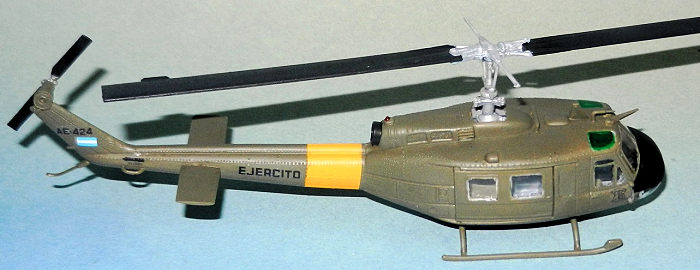 ber guns was firing at the Harriers (Hare’s plane was damaged). Other
helicopters in the dispersal were AE412 / 13 / 17 / 22 / 24 and were not
touched. After the danger was over, they all flew back to the area of Moody
Brook.
ber guns was firing at the Harriers (Hare’s plane was damaged). Other
helicopters in the dispersal were AE412 / 13 / 17 / 22 / 24 and were not
touched. After the danger was over, they all flew back to the area of Moody
Brook.
Once there, and with all the choppers dispersed in the area, Svendsen heard on the radio that an Argentine Navy Skyhawk A4-Q (3-A-312) was arriving in emergency. It was the sole survivor of the first 3-plane TABANO section that had seriously damaged HMS Ardent. Hit by the guns of a Sea Harrier and loosing fuel, Navy Lt. Jose Arca decided to try to land in the runway in Argentino/Stanley. But it was then discovered that one of the main landing gears was lost and he was therefore forced to bail out. Svendsen had helped on the radio to guide him to touch down. Arca ejected over land but the wind carried him out to the sea, where he landed approximately 300 to 400 meters away of the coast. Capt. Svendsen did not think it twice and took off to rescue the pilot from the freezing waters. While “Picho” was flying the helicopter, Sgt “Vinagre” Santana was controlling the gauges and 1st Corporal “Negro” San Miguel was trying to get hold of Arca and get him into the chopper. As Arca had his survival jacket and could not move his arms, this approach proved to be impossible. After 15 minutes of failure, Arca removed his jacket/vest and Svendsen sunk the skis of the Huey in the sea. Standing on these, San Miguel was able to take Arca from the arms and in that position; they flew 3 meters above the surface of the ocean back to the coast and when close to land they were told to keep on going 50 meters inland because the beach was mined. Just after passing the mine fields and having lost his strength San Miguel dropped Arca who fell from 1 meter over the ground. The helo landed beside him, Santana and San Miguel took him into the helo, closed the doors and put the AC at full blast (heating). Svensen ordered San Miguel to keep him awake because he was half frozen and to talk to him asking for name, rank, etc. Arca was flown straight away to the hospital. The following day San Miguel was called to the hospital as the Navy pilot wanted to talk to him. Beside his bed the commanders of the 3 Argentine Forces were standing up to congratulate the crew of the UH. Arca told San Miguel that he had attacked and hit a British ship, tangled with Harriers, had ejected, fell in the water but the only thing that he remembered vividly was the punches on the face that he received from the “Negro”. Jokingly he added that after leaving the hospital he would like to challenge him to a fight to see who was the strongest… Between the 21 and 26 some other missions were flown to move troops around.
On May 26th AE-412 / 13 / 22 and 24, led by
Svendsen in 424 took off to the Douglas Paddock area (20 km. away from San
Carlos) to retrieve the Combat Team Guemes, who had been walking for 3 days
after trying to fight off the landings in San Carlos on the 21st.
This team had managed to defend themselves by shooting down two helicopters and
damaged another one that had the mission to capture them. 600 meters away from
one of the areas that they had already overflown during their search 1st
Corporal San Miguel
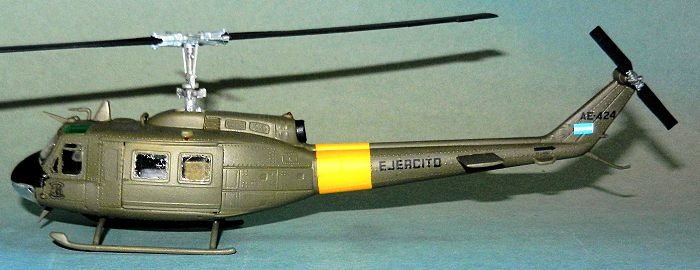 saw the movement of people beneath them. At first the team
led by 1st Lt. Carlos Esteban thought that they were British
helicopters looking for them and were hiding but after recognizing the yellow ID
bands used by the Argentines they came out of their hiding and that is when San
Miguel saw them. Everybody returned safe and sound to Argentino/Stanley.
saw the movement of people beneath them. At first the team
led by 1st Lt. Carlos Esteban thought that they were British
helicopters looking for them and were hiding but after recognizing the yellow ID
bands used by the Argentines they came out of their hiding and that is when San
Miguel saw them. Everybody returned safe and sound to Argentino/Stanley.
May 28th: with the British paratroopers closing in on Darwin-Goose Green, a mission to reinforce the Argentine troops was ordered. One Puma (AE-508), Two Augustas (AE-334-331), six UH (AE-424 /22 / 18 / 17 /13 / 12) and one Chinook (H-93 Argentine Air Force) took the troops. These were forced to land a little bit away from their original destination due to the intensive enemy fire. Once in flight and returning to Argentino/Stanley, they received a request to take some injured soldiers back with them. So Svendsen (with Santana and San Miguel), supported by Augusta AE-334 (Lt Florio and 1st Corporal Cravero) went back. Under enemy fire again, they were able to rescue a NCO and four soldiers.
May 29th: AE-424 with Svendsen took commandos to Mount Simmons. In the afternoon, they retrieved commandos from the area of Big Mountain, flying along with AE-424 (Lt Fernandez). As soon as they landed, they were warned about the presence of enemy helicopters. As it was almost night, both Hueys took off and after passing Mount Kent, with the lights of the town already in sight, Fernandez shouted on the radio: “To the ground, Picho!” Svendsen made such a violent maneuver that the commandos hit with the roof of the chopper and San Miguel lost his MAG machine gun (nicknamed Clotilde), which fell from the support after feeling a hit. Flying very low a British helicopter passed by firing his guns. Fernandez was also chased for some minutes but as they got close to the town, the British left them alone. The following day a hole from a bullet was found close to the support to the machine gun. San Miguel thinks that it is possible that the machine gun fell because of the bullet hit. Afterwards his fellow Army crews pulled his leg telling him that he had been a bad husband as he had lost his wife (as they are trained to protect and keep their weapons safe and never to lose them…as their wife). Another MAG was installed in AE-424. It was taken from one of the other UH that had been disabled and nicknamed Clotilde III (Clotilde II being San Miguel’s 9 mm gun).
June 5th: A nocturne mission to lure the British to the Argentine air defenses was ordered. Svensen called for volunteers and told his men that he would not take married ones. Svensen flew his AE-424 with 1st Lt. Perez Cometto replacing Santana and Corporal San Miguel who nevertheless decided to join the mission (though he was married). San Miguel told Svensen that they had come so far together that he was not going to leave him alone in this bad one. At 21:15 Svendsen took off and they saw some enemy helicopters in the Mount Kent area. While Perez was watching some enemy vehicles using his night vision goggles, they were ordered to return immediately as some enemy choppers had been detected flying from the North in their direction. Though they managed to lure the British to chase them they managed to evade them and returned to their base unharmed. No British helicopter was damaged.
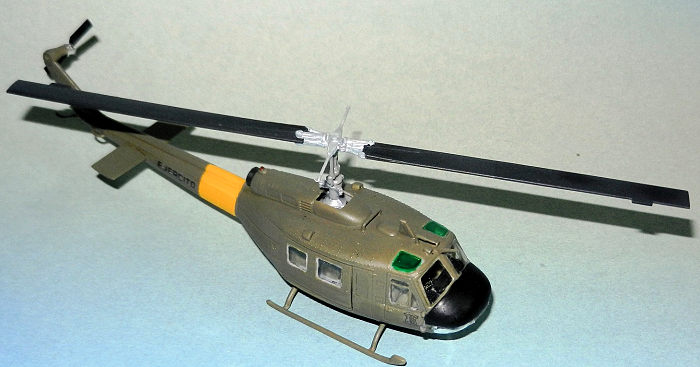 On June 6th, AE-424 / 18 and 22 took commandos
behind the enemy lines in the Murrell Bridge area. Under fire, they were able to
rescue some Argentine Navy Marines that had repelled an attack of the SAS.
Between June 8th and the 9th the Hueys repositioned
several troops in hills and the coastline.
On June 6th, AE-424 / 18 and 22 took commandos
behind the enemy lines in the Murrell Bridge area. Under fire, they were able to
rescue some Argentine Navy Marines that had repelled an attack of the SAS.
Between June 8th and the 9th the Hueys repositioned
several troops in hills and the coastline.
June 13th: AE-424 flew between 3.00 and 3.40 am to coordinate the fire of the Argentine guns, but at that moment the British ceased firing so the crew was unable to pinpoint the location of the enemy guns (west side of Mount Challenger).
After the cease-fire on the 14th, the six surviving Hueys were taken to the racetrack; among those, UH-424. Svendsen took injured soldiers to the Argentine Hospital Ship Irízar. On June 15th, Svendsen now flying for the first time AE-409, was authorized by the British to look for stranded and injured soldiers. But the bad weather conditions prevented them from completing their mission.
AE-424 was one of the Hueys captured in flying condition by the British troops. The Army pilots and crew were prisioners in Argentino/Stanley in a bunker built under their landing pads. It was very cold at night. Aboard the Argentine ship Bahia Paraiso they sadly left the islands on June 20th .'
For the rescue of Arca, the mission to rescue the soldiers under fire on the 28th and the bait mission at night Svendsen and San Miguel were one of the few decorated with the medal issued by the Argentine Nation to Bravery in Combat. “Picho” Svendsen retired from the Argentine Army with the grade of Lt. Colonel.
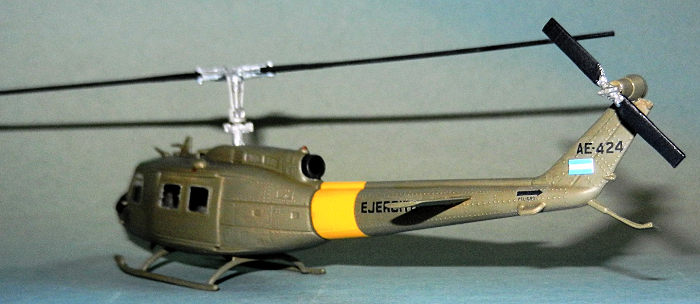 In regards to San Miguel he
continued in 601 till 1985 when he left the Army. A year later he joined the
Province of Buenos Aires Police as part of the GOE (Grupo de Operaciones
Especials – a.k.a. SWAT). The took 6 months of training as Commando and as
sniper. With the rank of Major he is still an instructor of snipers and tactical
groups. He lives with his wife in Berazategui, Buenos Aires Province and has 4
daughters and 2 grandkids. Medals that San Miguel received include among others
(besides the above mentioned Al Valor en Combate) , the one issued by the
Argentine Congress to the Veterans of the Malvinas War, several more given by
the Aviación de Ejercito including one for his actions in Malvinas, one given by
the Policia de Buenos Aires. He is also a Distinguised Citizen of Berazategui
City and he is in charge of the Cementery and Cenotaph for the Malvinas Veterans
located in the same town.
In regards to San Miguel he
continued in 601 till 1985 when he left the Army. A year later he joined the
Province of Buenos Aires Police as part of the GOE (Grupo de Operaciones
Especials – a.k.a. SWAT). The took 6 months of training as Commando and as
sniper. With the rank of Major he is still an instructor of snipers and tactical
groups. He lives with his wife in Berazategui, Buenos Aires Province and has 4
daughters and 2 grandkids. Medals that San Miguel received include among others
(besides the above mentioned Al Valor en Combate) , the one issued by the
Argentine Congress to the Veterans of the Malvinas War, several more given by
the Aviación de Ejercito including one for his actions in Malvinas, one given by
the Policia de Buenos Aires. He is also a Distinguised Citizen of Berazategui
City and he is in charge of the Cementery and Cenotaph for the Malvinas Veterans
located in the same town.
| THE KIT |
This is the second helicopter I have ever built (and contrary to what I had thought when I built my Italeri in 1/48). This was built due to a request of Miguel San Martin who wants to leave it as a memento to his daughters. The Hasegawa kit has practically no extra parts for alternative configurations. Using pictures from several websites and the Argentine references plus a key picture of AE-424 sent by San Miguel I was able to put build this Army helicopter quite accurately.
| CONSTRUCTION & PAINTING |
Cockpit: The interior of the cockpit goes together very well but it is very spartan. There is a decal for the instrument panel and having learnt my lesson with my 1/48th Italeri build I painted the pilots area in black with the passengers area in light gray FR35237. There are no seats for the troops supplied in the kit. The padded areas were painted olive green.
Fuselage: A considerable amount of putty and sanding are required in some unions (not very good, in fact, in the area around the engine and the nose) but nothing critical. The sliding doors were put glued in place and all the windows masked.
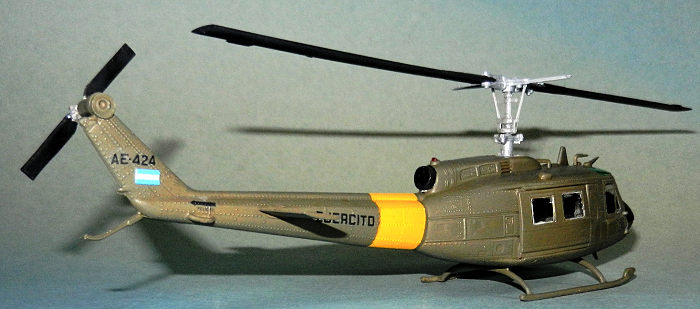 The yellow ID band applied to all
Argentine flying machines in the Theater was painted on the tail boom, masked
and the helicopter received a coat of Model Master Acryl 4728. Pretty
straightforward. Then the area around the nose was masked and this one was
painted in flat black.
The yellow ID band applied to all
Argentine flying machines in the Theater was painted on the tail boom, masked
and the helicopter received a coat of Model Master Acryl 4728. Pretty
straightforward. Then the area around the nose was masked and this one was
painted in flat black.
The decals from Aerocalcas give you all what you need for the Argentine Hueys and work very well with Set and Sol solutions. There are not, though, enough “4”s to make “424” so I had to resort to the spares to be able to put the numbers required in the 5 positions.
I added the rotating blades, painted the position lights and with MM Clear Green painted the panels on top of the pilots. It was quite a fast and easy build.
| CONCLUSIONS |
The Hasegawa kit shows its age with all those huge rivets and somehow dubious fit plus flash in many parts. This one will be delivered to “Negro” San Martin in the coming weeks as my tribute to his courage and the ones of his friends in 1982.
Note: after San Miguel’s correction when he saw my 1/48th article I then masked the nose of my Italeri kit and when I painted his kit I also painted mine which is now fixed. https://modelingmadness.com/review/mod/us/calh1.htm
| REFERENCES |
Interview with “Negro” San Martin
Angeles sobre la Turba (Antonio Falcon)
Falklands Air War (Hobson)
A4-Q (Nunez Padin)
Copyright ModelingMadness.com
If you would like your product reviewed fairly and fairly quickly, please contact the editor or see other details in the Note to Contributors.
Back to the Main Page Back to the Review Index Page Back to the Previews Index Page